13 Centuries of the Nordic Peoples
Text and maps copyright Howard Wiseman 2009-2021.
Last Modified: 21st October 2021
The Nordic nations (the Danes, Norwegians,
and Swedes, and related peoples) appear most prominently in the pages
of history during Viking times (roughly 789-1098). This site
covers that period in detail, but also charts their history in more
recent times, which has much of interest. The dates chosen for this
site are, with the exception of the start, end, and 1864, chosen to
show the greatest extents of the power or influence of various Nordic
nations. There is one map per century from the 8th to the 13th century,
and then one every second century thereafter.
Return to Howard Wiseman's History page
Note: to view these maps as a coarse "movie", first adjust the size of
this window to be slightly larger than a map plus its title, then click
on next (>) or previous (<) at the beginning of each title. To
return
to the Index of Maps, click on the up arrow (^).
Index of Maps
789 -- Scandinavia before the storm
878 -- The Viking Invasions of Britain
972 -- The Rus Empire of Svyatoslav
1028 -- The Danish Empire of Cnut
1130 -- The Norman Conquests
1223 -- The Danish Empire of Valdemar II
1460 -- The Union of Kalmar under Christian I
1655 -- The Swedish Empire under Charles Gustav
1864 -- The loss of Schleswig-Holstein
2009 -- The Nordic nations today
13 Centuries of the Nordic Peoples --- a Summary Map
^ > 789
-- Scandinavia before the storm
Danes, Norwegians, Swedes

The
Nordic people have been living in Scandinavia for thousands of
years. In the sixth century they had raided northern Francia, and may
have participated in the Anglo-Saxon conquest of England. But for the
most part they went unnoticed in European history. This all changed
with the first recorded raid on England in 789, which launched the
Viking Age. What prompted this change in Nordic culture remains
controversial; it may have been over-population; or advances
in ship-design which opened new opportunities; or Charlemagne's
bloody conquest and conversion of the pagan Saxons, which brought the
Frankish Empire to the borders of the Kingdom of Denmark (shown in red
on the above map). Note that although it is reasonable even at this
early time to divided the Nordic people into the three
nations that persist to the present day in Scandinavia: the Danes, Norwegians, and Swedes, only the first of these was organized into a single Kingdom at this time.
< ^
> 878
-- The Viking Invasions of Britain
Danes, Norwegians, Swedes
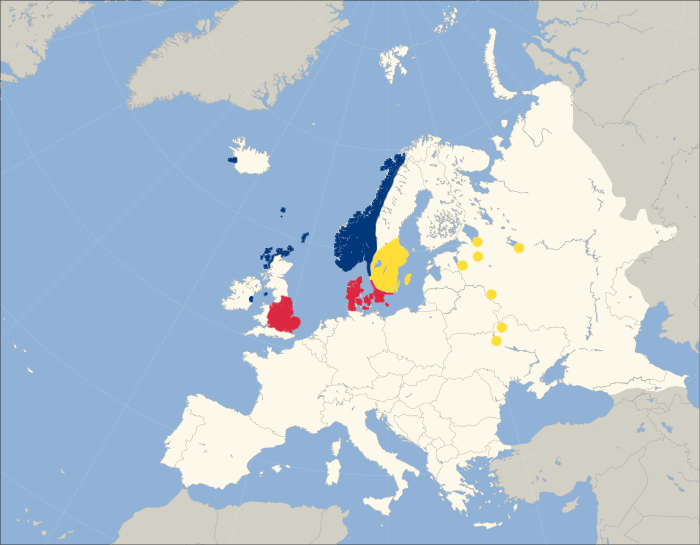
The
first Danish raid of three ships in Wessex in 789 was followed
by the infamous sack of the monastery of Lindisfarne in Northumbria in
793 by Norwegian Vikings (or Norse, as they are called). Over the next
two generations, the scale and area of Viking activity exploded. They
set up bases and sacked towns throughout England and France (i.e.
western Francia), and along the coasts of Spain, Africa and Italy.
Their fleets could number more than a hundred ships, enough to carry an
army of several thousand men. By the 860s, the cavalry forces of
local French nobles had learned how to respond rapidly to the Danes,
rather than waiting for their King to turn up. The Danes therefore
turned their attention towards the easier pickings in England. In
865 the "Great Army" under Ivar and Halfdan invaded. York fell in 866,
although the northern part of Northumbria remained independent. East
Anglia was next in 869, and Mercia in 873. Only Wessex remained, and in
878, King Alfred, defeated, had fled to the Somerset marshes. The
Norse, meanwhile had conquered the northern Scottish Isles, Man,
and Dublin, and had established the first settlement in the Faroes and Iceland (previously
uninhabited). In the east, Swedish Vikings (also
known as
Varangians) were establishing control of key trading towns on the great
rivers of Russia.
< ^
> 972
-- The Rus Empire of Svyatoslav
Denmark, Normandy, Norway, Hiberno-Norse, Swedes, Varangian Rus, Iceland
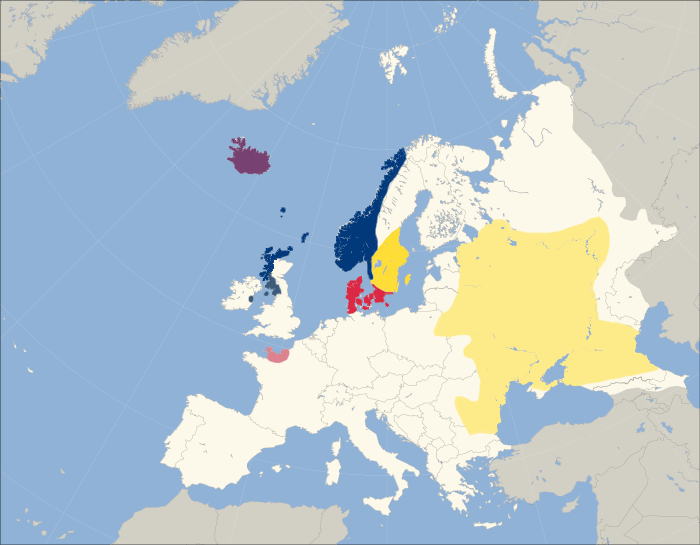
The Danish army had divided after its conquest of Mercia, but Alfred's
victory over that fraction which had invaded Wessex was remarkable
nevertheless. Gradually over the next two generations the House of
Wessex reconquered all the Danish gains, and established the Kingdom of
England. The Danes turned again on France, and in 911 Charles the
Simple bought off the Viking Rollo by granting him a small piece of
territory at the mouth of the Seine. Rollo was baptised and
held his land as a vassal of the King, but this was purely nominal. By the time of
this map, the Normans (that is, Northmen) had greatly expanded territory of Normandy. They were already becoming more French than Danish, but were still very conscious of
their Viking roots. The Norse, meanwhile, had conquered all of
western Scotland, while in Dublin, Man, and Strathclyde, mixed Hiberno-Norse elites ruled (in the last case, mixed also with the Strathclyde Britons). The Icelanders, drawn from all over the Nordic world, had created an island-wide system of government by Thing
(assembly) in 930, around the same time the Norwegians were unified
under a single King. But the most spectacular gains at this time were
by the Varangians, who were known by the locals as the Rus. In 882, Oleg took control of Kiev and made it the capital of an Empire encompassing all the Rus settlements. The Varangian Rus
Empire reached its greatest extent under Svyatoslav (945-72), but as
his name betrays, by this time they were becoming integrated with the
local Slavic population.
< ^
> 1028
-- The Danish Empire of Cnut
Danish Crown, Normandy, Sweden, Iceland, Greenlanders
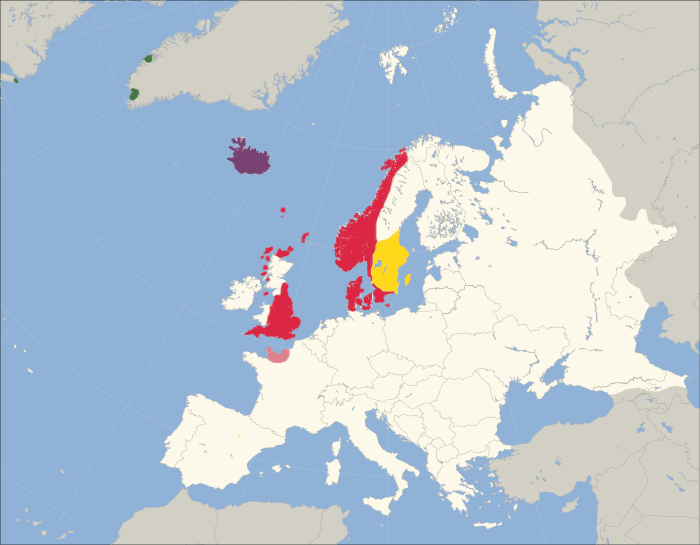
By the early 11th century Varangian trade with the east had dried
up with the exhaustian of silver mines in Dar al-Islam. The Rus Empire persisted, but was now definitely Russian (slavic
speaking, land-based, and Orthodox Christian) rather than Nordic. But
in the west Viking activity was on the rise again. England
was subject to massive Danish raids from 991 onwards; the Danegeld King
Ethelred repeatedly paid
them to turn away served only to encourage them to return in future
years. Their fleets were helped by the safe havens they were granted in
Normandy, which was now a Dukedom. By 1016, Cnut, brother of the King
of Denmark, had conquered the whole
of England. In 1019 he inherited Denmark, and in 1028
conquered the Norwegians when they allied with Swedes (recently
united under a single King) against
him. With Norway came the Earldom of Orkney, from the Shetland
Isles to the Isle of Man; Cnut had created the only ever Empire of the
North Sea. Meanwhile, beyond Iceland, Viking settlers had reached
Greenland in 986, and the Greenlanders
colonised "Vinland" a generation later. The latter has been identified with (or at least included)
the Viking settlement of L'Anse aux Meadows
in Newfoundland, and a recent (2021) study has shown that trees were being felled there
in 1021. It is thus plausible that it was still occupied in 1028, but was abandoned not long after.
< ^
> 1130
-- The Norman Conquests
Denmark, Normans, Norway, Sweden, Iceland, Greenlanders
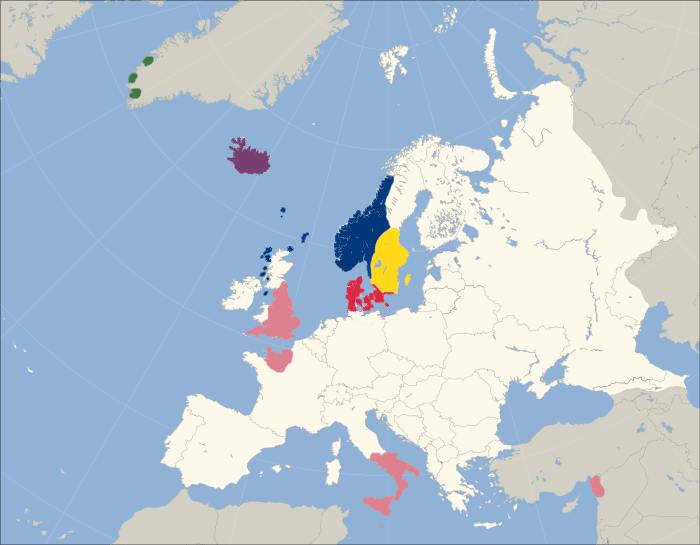
Cnut's
Empire did not survive his death in 1035, and Danish rule in England
ended in 1042. But the restoration of the House of Wessex was
also short-lived --- when the half-Norman Edward "the Confessor" died
without a son in 1066,
the Kingdom was up for grabs. The main contenders were:
the half-Danish Harold, Earl of Wessex (the most powerful man in
England), Harald Hardrada, King of Norway (with a weak claim to be
Cnut's successor), and
William the Bastard(*), Duke of Normandy (Edward's cousin once-removed,
and his nominated heir). Two great battles on English soil determined that
the last was to become King William I of England. But this famous Norman
Conquest of 1066
was not the only one of this century, for even if they now lived as
Frenchmen, the Normans still had the Viking wanderlust. From
1040, Norman mercenaries in southern Italy began
grabbing land for themselves, and by 1091 had conquered almost the whole of
it, plus Sicily from the Moors. These lands were united under Roger,
Count of Sicily, who took the title King in 1130. Meanwhile, Normans
from Normandy, England, and Italy were among those who had joined the
First Crusade against the Seljuks in the East in 1096. Bohemond, a
Norman from Italy, won for himself the rule of Antioch, and the title
Prince, in 1099.
(*)
The Normans' willingness, at this stage, to recognize their
illegitimate offspring as heirs was another legacy of their Viking
past; they called their concubines "Danish wives".
< ^
> 1223
-- The Danish Empire of Valdemar II
Danish Crown, Norway, Sweden, Iceland, Greenlanders

Norman
rule ended: in the Principality of Antioch with the death of
Bohemond's son, Bohemond II, in 1131; in England and
Normandy with the death of Stephen, grandson of William I, in 1154; and in the Kingdom of Sicily with its
conquest by the Holy Roman Emperor Henry VI in 1194.
After this, the next major Nordic conquest was the creation of a Baltic
Empire by Valdemar II, King of Denmark, known as the Conqueror.
He began by invading Norway, which became his vassal from 1208. Denmark
had been increasing its influence in northern Germany for some time,
and in 1214, Valdemar's military support of the beleagered Holy Roman
Emperor Frederick II (son of Henry VI) was rewarded with the transfer of the whole coast
of Germany east of the Elbe to Denmark. In 1219 he conquered northern
Estonia, as part of a Crusade against the pagans there, and shortly
afterwards took northern Courland (Latvia) [Kinder & Hilgemann,
1964]. By this time the Swedes had begun their colonization of
Finland.
< ^
> 1460
-- The Union of Kalmar under Christian I
Danish Crown

In
1223 Valdemar II was captured by one of his north German vassals, and
only released a year later after promising to give up his German
territories. He soon reneged on this promise, but defeat in 1227 forced
him to accept this loss. Northern Estonia remained Danish until 1346,
when it was sold to the Teutonic Knights. Meanwhile in the west Nordic
rule was also retreating --- the Isle of Man and the Hebrides were sold
by Norway to Scotland in 1266, following an inconclusive
war. However, Norway had won a far bigger prize in 1262 when the Icelanders voluntarily placed
themselves under the Norwegian Crown. (The Greenlanders followed suit, but sadly, due to the deteriorating
climate event known as the "Little Ice Age", they
fell out of contact with their Nordic cousins and, by the time of
this map, had perished through famine.) This was the beginning of
a trend that culminated in the 1397 Treaty of Kalmar, which brought all
the Nordic peoples under one King. The chief architect of this Union
was Queen Margaret of Norway, who remained the power behind the throne
of her grand-nephew Erik until her death in 1412. Thereafter the Danes
became the dominant power in the Union, and the Swedes in particular
often rose up against what they saw as an imposed foreign ruler.
However in 1460 Christian I was unopposed King of all the Nordic
nations, and had just extended Denmark to the south again by annexing
Schleswig-Holstein.
< ^
> 1655
-- The Swedish Empire under Charles Gustav
Danish Crown, Swedish Crown, Swedish occupying forces
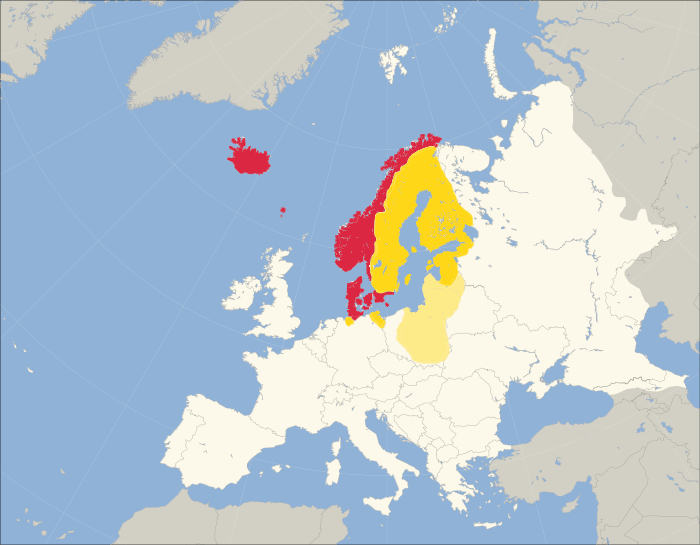
Christian
I was chronically short of money, because the nobles he relied upon for
support paid little or no tax. In 1468 he pawned Orkney and
Shetland to Scotland, to cover the unpaid dowry of his daughter
Margaret (betrothed to the Scottish King). Earlier, in 1464, the Swedes
had risen again in rebellion against his financial impositions, and
restored one of their own Kings. Danish Kings were able to reimpose
their authority at times in Sweden, but the massacre of Stockholm in
1520 and the subsequent rebellion saw the final end of the Kalmar Union
in 1523. The Norwegians and Icelanders remained under Danish Kings, but
it was Sweden which became in the following century one of the
"Great Powers" of Europe. Sweden emerged from the
thirty-year's war (1618-48) with an Empire in the Baltic and northern
Germany, and an army that was second-to-none in Europe. This was
a remarkable achievement, since Sweden's population was only
about 1/5 of that of Britain (the next-least populous Great Power), and
far poorer. It rested on the militarisation of the Swedish people, the
generalship of their Kings, and, especially after 1648, subsidies by
France. In 1655 King Charles (traditionally numbered the 10th of that
name), surnamed Gustav, opportunistically took Sweden to war against
the Polish-Lithuanian Commonwealth. Russia had invaded the year before,
and the Swedish forces quickly overran what was left of the country, in
what was remembered in Polish history as "The Deluge". This area
is shown above in light yellow, as it was an occupation which never
crystallized into a conquest.
< ^
> 1864
-- The loss of Schleswig-Holstein
Danish Crown, Swedish Crown

Charles
Gustav was forced to withdraw by Polish nationalist forces in 1657.
However, he immediately went to war with Denmark, and by 1658 the Danes
had ceded that part of Denmark on the southernmost point of the
Scandinavian peninsula, and the central part of Norway, around
Trondheim. The former turned out to be a permanent conquest; the latter
was returned to Denmark-Norway in 1660. Sweden continued to act as Great Power
in Scandinavia and the east until it was finally defeated in the Great
Northern War of 1700-21, by an overwhelming coalition of Russia,
Denmark-Norway, Poland-Lithuania and Saxony. Sweden lost all of its
territories except for Finland and Pomerania. In 1814, following the Napoleonic wars, these remaining territories were given to
Russia and Prussia respectively by the Great Powers (which no longer included Sweden). However, Sweden
was compensated because it had fought against Napoleon (and Denmark
punished because it had allied with him) by the transfer of
Norway from the Danish to the Swedish Crown. The original Norwegian
claims to Iceland, Greenland and the Faroes had, however, already been
transferred to the Danish Crown. The final loss of Nordic territory
occurred in the 1864, when Prussia and Austria-Hungary wrested Schleswig-Holstein (which was predominantly
German speaking) from Denmark. By this time, Denmark had begun
reoccupying Greenland, where Eskimo peoples, who had inhabited the far
north for millennia, had spread to the south by c.1500 (and may
have had a hand in the demise of the Nordic settlers there).
< ^ 2009 -- The Nordic Nations today.
Denmark, Greenland, Norway, Sweden, Finland, Iceland
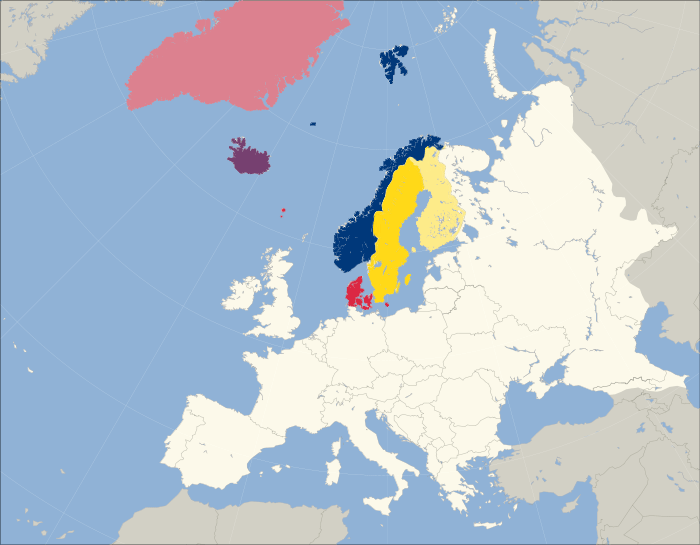
The
Norwegians had never been happy under Swedish rule, and the union could
not survive the spread of democracy to Scandinavia. When a referendum
in 1905 returned a tally 99.95% in favour of dissolution
(among the 85% of Norwegian men who voted), Sweden accepted the
inevitable. Following the First World War, in which all the Nordic
nations were neutral, Denmark regained the Danish-speaking part of
Schleswig, Norway gained sovereignty over the Arctic Island of
Svalbard, and Finland gained its independence from Russia. Since then,
the proportion of native Swedish speakers in Finland has dropped from
about 11% to only half that, but Swedish remains an official language,
hence the colouring of Finland.
In Greenland, by contrast, which gained full autonomy from Denmark on
21 June 2009, Kalaallisut (an Eskimo tongue) is the only official
language. However Danish is spoken by most citizens of Greenland, and remains
the language of higher education, hence the colouring of Greenland. Iceland, meanwhile, voted in 1944 for full independence from Denmark as a republic; the other fully Nordic nations (Denmark, Norway, and Sweden) remain monarchies.
13 Centuries of the Nordic Peoples --- a Summary Map
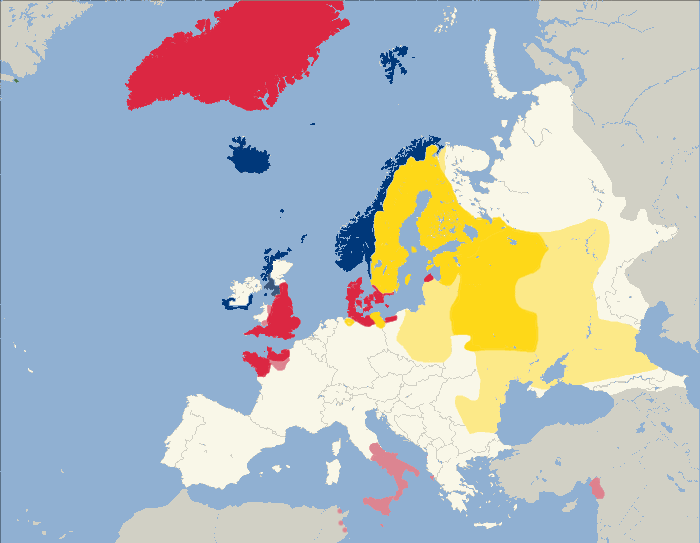
The
coloured areas of this map shows areas ruled or occupied by Nordic
peoples at any time in the last 13 centuries. The colourings are as
follows: Areas ruled by Denmark, or Danish Vikings; Areas ruled by Norway or Norse Vikings; Areas ruled by Sweden or Swedish Varangians; Areas ruled by Normans; Areas ruled by Varangian Rus, or temporarily occupied by Sweden; Area ruled by Hiberno-Brittono-Norse; Area colonised by Greenland Vikings. Since
many areas fall into more than one of these categories, the colouring
is somewhat arbitrary. I have tended to choose a colouring which
emphasizes the greatest territorial expansion of the three original
Nordic nations, the Danes, Norwegians, and Swedes.
A few territories coloured here do not appear on the earlier maps on
this site. The main ones are: (i) Norse colonies in southern Ireland (early to
mid 10th century); (ii) Viking-ruled Brittany (914-39); and (iii)
conquests by the Norman Kingdom of Sicily: Spoleto in central
Italy (1144-94); the Island
of Corfu (1147-49), and Tunis and other African
cities, including some beyond the borders of this map, (1146-60). Other
areas that are beyond the borders of the map are the former
trans-oceanic colonies of Sweden and Denmark in West Africa,
India, North America, and the Caribbean, and the current Norwegian
Antarctic territories. Even without counting these (or indeed Greenland), the Nordic and once-Nordic
territories shown cover almost half of Europe, and touch upon another three other continents:
Asia, Africa
and North America.
Selected Bibliography
- A. Bereznay (map-maker), The Times Atlas of European History (Time, London,
1994).
- L. Brownworth, Norman Centuries (Podcasts, 2009-10) http://www.normancenturies.com
- J. Haywood, The Penguin Historical Atlas of the Vikings (Penguin,
London, 1995)
- R. Ferguson, The Vikings: A History (Viking Press, 2009)
- H. Kinder and W. Hilgemann, The Penguin Atlas of World History, Vol. I (Penguin,
London, 1978)
- M. Kuitems et al., "Evidence for European presence in the Americas in AD 1021", Nature, 2021.
- C. McEvedy, The New Penguin Atlas of Medieval History (Penguin,
London, 1992).
- C. McEvedy and R. Jones, Atlas of World Population History (Penguin,
London, 1978).
- Danish Kings and their history http://www.danskekonger.dk/eng/index.html
- Historical Atlas - Scandinavia http://www.tacitus.nu/historical-atlas/scandinavia/
Return to Howard Wiseman's History page










